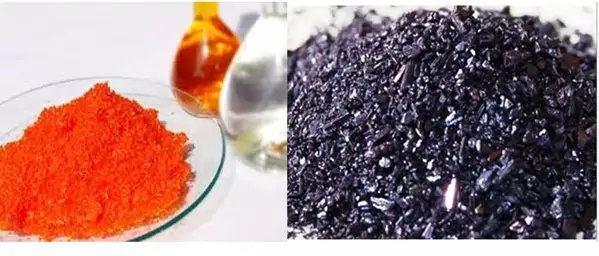Preparation and Properties of Potassium Permanganate and Potassium Dichromate
Preparation and Properties of Potassium Permanganate and Potassium Dichromate:
General Properties of First Row Transition Metal Compounds Oxides and oxometal ions:
(i) Oxides of metals in low oxidation states + 2 and + 3 (MO, M3O4 and M2O3) are generally basic except Cr2O3 which is amphoteric in character.
(ii) Oxides of metals in higher oxidation states + 5 (M2O5, MO3, M2O7) are generally acidic in character.
(iii) Oxides of metals in their intermediate oxidation states + 4 (MO2) are generally amphoteric in nature. Besides the oxides, the oxocations, which stabilise V (V) species is VO2+, V (IV) species is VO2+ and Ti(IV) species is TiO2+.
(iv) As the oxidation number of the metal in the oxide increases, ionic character decreases and acidic character increases.
Thus, +2 +8/3 +3 +4 +7
MnO Mn3O4 Mn2O3 MnO2 Mn2O7
→ Ionic Character Decreases
→ Acidic Character Increases
Preparation of Potassium dichromate (K2Cr2O7): It is prepared by the reaction of chromate ore (FeCr2O4) with sodium carbonate in excess of air.
Step 1: Conversion of chromite ore to sodium chromate
4 FeCr2O4 + 8 Na2CO3 + 7 O2 → 8 Na2CrO4 + 2 Fe2O3 + 8 CO2
Step 2: Acidification of sodium chromate to sodium dichromate
2Na2CrO4 + 2 H+ → Na2Cr2O7 + 2 Na+ + H2O
Step 3: Conversion of sodium dichromate to potassium dichromate
Na2Cr2O7 + 2 KCl → K2Cr2O7 + 2 NaCl
Physical properties:
It forms orange-red crystals which melt at 396 0
It is moderately soluble in cold water but freely soluble in hot water.
Chemical properties:
The chromate and dichromate are inter-convertible in aqueous solution depending upon pH of the solution. Chromate on acidification gives dichromate and the dichromate on treating with alkali gives chromate.
2 CrO42– + 2H+ → Cr2O72– + H2O
Cr2O72– + 2OH– → 2 CrO42– + H2O
The oxidation state of chromium in chromate and dichromate is +6.
The structures of chromate ion, CrO42– and the dichromate ion, Cr2O72– are shown below.
Sodium and potassium dichromates are strong oxidising agents. The sodium salt has a greater solubility in water and is extensively used as an oxidising agent in organic chemistry.
The action of Alkalies: When an alkali is added to an orange-red solution of dichromate, a yellow solution results due to the formation of chromate.
K2Cr2O7 + KOH → K2CrO4 + H2O
Oxidising Properties: K2Cr2O7 is a good oxidising agent in an acidic medium. Its oxidising action can be represented as follows:
Cr2O72– + 14H+ + 6e– → 2Cr3+ + 7H2O
Thus, acidified potassium dichromate will oxidise
(i) Iodides to iodine
6 I – → 3I2 + 6 e–
Cr2O72– + 14H+ + 6e– → 2Cr3+ + 7H2O
—————————————————–
6I – + Cr2O72– + 14H+ → 3I2 + 2Cr3+ + 7H2O
(ii) Sulphides to sulphur
3S2- →3 S + 6e–
Cr2O72– + 14H+ + 6e– → 2Cr3+ + 7H2O
—————————————————–
3S2- + Cr2O72– + 14H+ → 3S + 2Cr3+ + 7H2O
————————————————-
(iii) Tin(II) to tin(IV)
3 Sn2+ → 3Sn4+ + 6 e–
Cr2O72– + 14H+ + 6e– → 2Cr3+ + 7H2O
———————————————–
3Sn2+ + Cr2O72– + 14H+ → 3 Sn4+ + 2Cr3+ + 7H2O
————————————————————-
(iv) Iron(II) (ferrous) to iron(III) (ferric)
6 Fe2+ → 6Fe3+ + 6 e–
Cr2O72– + 14H+ + 6e– → 2Cr3+ + 7H2O
—————————————————–
Cr2O72– + 14 H+ + 6 Fe2+ → 2 Cr3+ + 6 Fe3+ + 7 H2O
—————————————————————-
(v) It oxidises ethyl alcohol to acetaldehyde and acetic acid
K2Cr2O7 + 4 H2SO4 → K2SO4 + Cr2(SO4)3 + 4H2O +3O
CH2CH2OH + O → CH3CHO + H2O
CH3CHO + O → CH3COOH
Acetaldehyde Acetic Acid
Test for a drunken driver. The above reaction helps to test whether a driver has consumed alcohol or not. he is asked to breathe into the acidified K2Cr2O7 solution taken in a test tube. If the orange colour of the solution changes into green colour (due to Cr2(SO4)3 formed in the reaction), the driver is drunk, otherwise not.
Chromyl chloride test (Reaction with chloride and conc. sulphuric acid): When heated with concentrated hydrochloric acid or with chloride and strong sulphuric acid, reddish-brown vapours of Chromyl Chloride are obtained.
K2Cr2O7 + 6 H2SO4 + 4 KCl → CrO2Cl2 + 6 KHSO4 + 3H2O
Chromyl Chloride
Uses:
(i) In volumetric analysis, it is used as a primary standard for the estimation of Fe2+ (ferrous ions) and I– (iodides) in redox titrations.
(ii) In industry, it is used
(a) In chrome tanning in the leather industry.
(b) In the preparation of chrome alum K2SO4.Cr2(SO4)3. 24H2O and other industrially important compounds such as Cr2O3, CrO3, CrO2Cl2, K2CrO4, CrCl3 etc.
(c) In calico printing and dyeing.
(d) In photography and in hardening gelatine film.
Preparation of Potassium Permanganate (KMnO4): Potassium permanganate is commercially prepared from Pyrolusite (MnO2). The preparation involves two steps.
Step 1: MnO2 is fused with KOH to form potassium manganate (K2MnO4).
2 MnO2 + 4 KOH + O2 → 2 K2MnO4 + 2 H2O
Step 2: K2MnO4 is electrolytically oxidised to potassium permanganate.
3 MnO42- + 4 H+ → 2 MnO4– + MnO2 + 2 H2O
Properties: Potassium permanganate forms dark purple crystals which are iso-structural with those of KClO4. When heated it decomposes and liberate O2.
2KMnO4 → K2MnO4 + MnO2 + O2
The manganate and permanganate ions are tetrahedral

The green manganate is paramagnetic with one unpaired electron but the permanganate is diamagnetic.
Preparation and Properties of Potassium Permanganate and Potassium Dichromate
Properties of KMnO4:
(i) Colour: Potassium permanganate exists as a deep purple-black colour with a greenish lustre which becomes dull in the air due to superficial reduction.
(ii) Solubility: It is moderately soluble in water at room temperature and it is more soluble in hot water.
(iii) Action of heat: When heated to 513 K, it readily decomposes giving oxygen.
KMnO4 → K2MnO4 + MnO2 + O2
At red heat, potassium manganate formed decomposes into potassium manganite (K2MnO3) and oxygen
K2MnO4 → K2MnO3 + O2
The action of heat in a current of Hydrogen: When heated in a current of H2, solid KMnO4 gives KOH, MnO and water vapours.
2 KMnO4 + 5 H2 → 2 KOH + 2 MnO2 + 4 H2O
Preparation and Properties of Potassium Permanganate and Potassium Dichromate
Oxidising properties:
KMnO4 is a good oxidizing agent in acidic, basic and neutral media. The oxidizing action in acidic medium is due to the reaction:
MnO4– + 8H++ 5e–→ Mn2+ + 4H2O
Acidified permanganate solution oxidises:
(i) Oxalates to carbon dioxide
5 × (C2O42-→2 CO2 + 2e–)
2 × (MnO4– + 8H++ 5e–→ Mn2+ + 4H2O)
5 C2O42- +2 MnO4– + 16H+ → 10 CO2 +2 Mn2+ + 8H2O
——————————————————————
(ii) Iron(II) to iron(III)
5 Fe2+ → 5 Fe3+ + 5e–
MnO4– + 8H++ 5e–→ Mn2+ + 4H2O
5Fe2+ + MnO4– + 8H+ → 5Fe3+ + Mn2+ + 4H2O
——————————————————-
(iii) Nitrites to nitrates
5NO2– + 5H2O → 5NO3– + 10H+ + l0e–
2 × (MnO4– + 8H++ 5e–→ Mn2+ + 4H2O)
—————————————————————
5NO2– +2 MnO4– + 6H+ → 5NO3– + 2 Mn2+ + 3H2O
————————————————————
In alkaline or neutral medium, permanganate ion is reduced to
MnO2 MnO4– + 2H2O + 3e–→ MnO2 + 4OH–
In alkaline medium it oxidises:
(i) Iodide to iodate
(MnO4– + 2H2O + 3e–→ MnO2 + 4OH–) × 2
I– + 6OH– → IO3– + 3 H2O + 6 e–
——————————————————
MnO4– + H2O + I–→ 2MnO2 + 2OH–+ IO3
——————————————————
(ii) Thiosulphate to sulphate
(MnO4– + 2H2O + 3e–→ MnO2 + 4OH–) × 8
(S2O32- + 10OH– → 2SO42- + 5 H2O + 8e-) × 3
—————————————————————-
8MnO4– + H2O +3 S2O32- → 8MnO2 + 2OH–+ 6SO42-
—————————————————————-
Uses: It is used as an oxidising agent in acidic, basic and neutral medium. It is used as a primary standard in volumetric analysis. It is used for the bleaching of wool, cotton, silk and other textile fibres and also for the decolourisation of oils.
f-Block Elements and Properties
https://sciencemotive.com/class-12-chemistry/f-block-elements-and-properties/
Preparation and Properties of Potassium Permanganate and Potassium Dichromate




